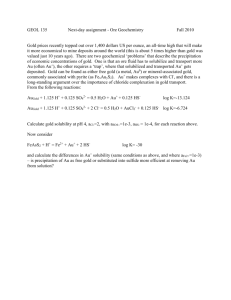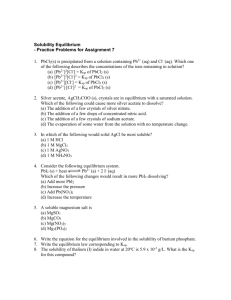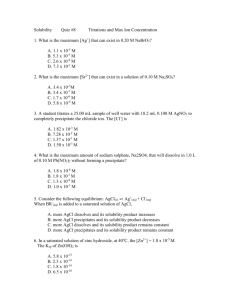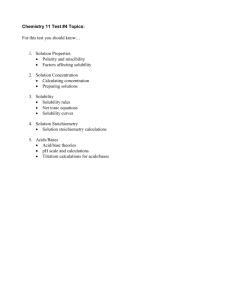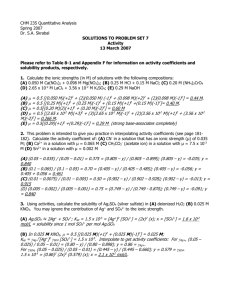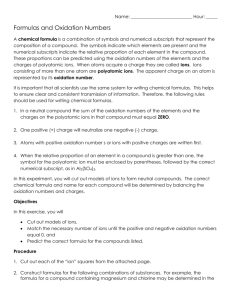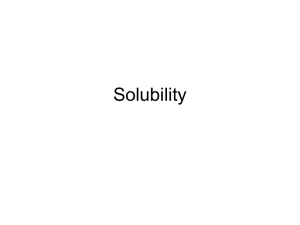L3solubilitysummary - chemicalminds
advertisement
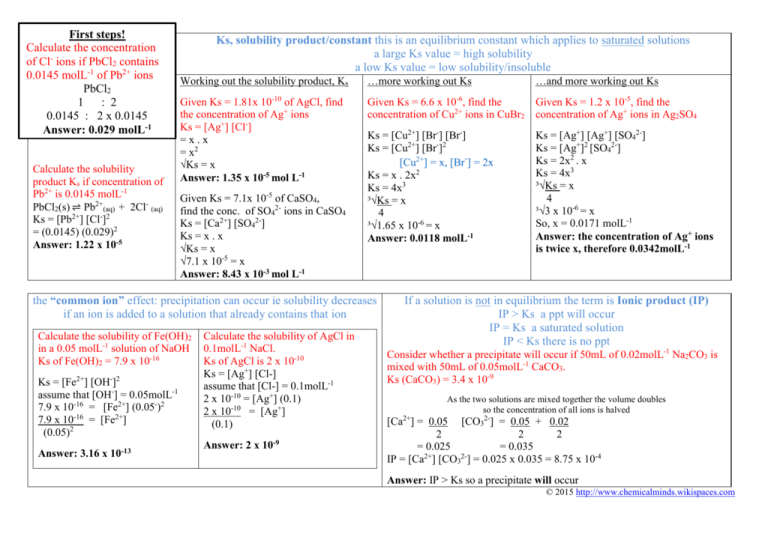
First steps! Calculate the concentration of Cl- ions if PbCl2 contains 0.0145 molL-1 of Pb2+ ions PbCl2 1 : 2 0.0145 : 2 x 0.0145 Answer: 0.029 molL-1 Calculate the solubility product Ks if concentration of Pb2+ is 0.0145 molL-1 PbCl2(s) ⇌ Pb2+(aq) + 2Cl- (aq) Ks = [Pb2+] [Cl-]2 = (0.0145) (0.029)2 Answer: 1.22 x 10-5 Ks, solubility product/constant this is an equilibrium constant which applies to saturated solutions a large Ks value = high solubility a low Ks value = low solubility/insoluble Working out the solubility product, Ks …more working out Ks …and more working out Ks Given Ks = 1.81x 10-10 of AgCl, find the concentration of Ag+ ions Ks = [Ag+] [Cl-] =x.x = x2 √Ks = x Answer: 1.35 x 10-5 mol L-1 Given Ks = 6.6 x 10-6, find the concentration of Cu2+ ions in CuBr2 Given Ks = 1.2 x 10-5, find the concentration of Ag+ ions in Ag2SO4 Ks = [Cu2+] [Br-] [Br-] Ks = [Cu2+] [Br-]2 [Cu2+] = x, [Br-] = 2x Ks = x . 2x2 Ks = 4x3 ³√Ks = x 4 ³√1.65 x 10-6 = x Answer: 0.0118 molL-1 Ks = [Ag+] [Ag+] [SO42-] Ks = [Ag+]2 [SO42-] Ks = 2x2 . x Ks = 4x3 ³√Ks = x 4 ³√3 x 10-6 = x So, x = 0.0171 molL-1 Answer: the concentration of Ag+ ions is twice x, therefore 0.0342molL-1 Given Ks = 7.1x 10-5 of CaSO4, find the conc. of SO42- ions in CaSO4 Ks = [Ca2+] [SO42-] Ks = x . x √Ks = x √7.1 x 10-5 = x Answer: 8.43 x 10-3 mol L-1 the “common ion” effect: precipitation can occur ie solubility decreases if an ion is added to a solution that already contains that ion Calculate the solubility of Fe(OH)2 in a 0.05 molL-1 solution of NaOH Ks of Fe(OH)2 = 7.9 x 10-16 Ks = [Fe2+] [OH-]2 assume that [OH-] = 0.05molL-1 7.9 x 10-16 = [Fe2+] (0.05-)2 7.9 x 10-16 = [Fe2+] (0.05)2 Answer: 3.16 x 10-13 Calculate the solubility of AgCl in 0.1molL-1 NaCl. Ks of AgCl is 2 x 10-10 Ks = [Ag+] [Cl-] assume that [Cl-] = 0.1molL-1 2 x 10-10 = [Ag+] (0.1) 2 x 10-10 = [Ag+] (0.1) Answer: 2 x 10-9 If a solution is not in equilibrium the term is Ionic product (IP) IP > Ks a ppt will occur IP = Ks a saturated solution IP < Ks there is no ppt Consider whether a precipitate will occur if 50mL of 0.02molL-1 Na2CO3 is mixed with 50mL of 0.05molL-1 CaCO3. Ks (CaCO3) = 3.4 x 10-9 As the two solutions are mixed together the volume doubles so the concentration of all ions is halved [Ca2+] = 0.05 [CO32-] = 0.05 + 0.02 2 2 2 = 0.025 = 0.035 IP = [Ca2+] [CO32-] = 0.025 x 0.035 = 8.75 x 10-4 Answer: IP > Ks so a precipitate will occur © 2015 http://www.chemicalminds.wikispaces.com
